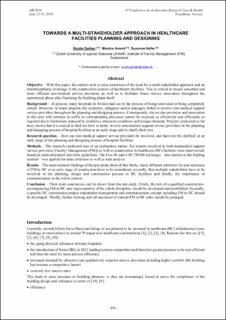| dc.description.abstract | Objective – With this paper, the authors seek to raise awareness of the need for a multi-stakeholder approach and an interdisciplinary exchange in the construction context of healthcare facilities. This is critical to ensure smoother and more efficient non-medical service provision, as well as to facilitate future service innovation throughout the operational phase after finalising the building phase itself.
Background – At present, many hospitals in Switzerland are in the process of being renovated or being completely rebuilt. However, in many projects, the architects, designers and/or managers failed to involve non-medical support service providers throughout the planning and designing process. Consequently, the service provision and innovation in this area will continue to suffer as corresponding processes cannot be executed as effectively and efficiently as required due to limitations imposed by restrictive structural conditions and design elements. Projects conducted so far have shown that it is crucial to find out how to better involve non-medical support service providers in the planning and designing process of hospital facilities at an early stage and to clarify their role.
Research question – How can non-medical support service providers be involved, and their role be clarified, at an early stage of the planning and designing process of hospital facilities.
Methods – The research conducted was of an exploratory nature. Six experts involved in both nonmedical support service provision [Facility Management (FM)] as well as construction in healthcare (HC) facilities were interviewed, based on semi-structured interview guidelines. The Five-W-and-1-H (5W1H) technique – also known as the Kipling method – was applied for data collection as well as data analysis.
Results – The main research findings of this pre-study showed that firstly, many different inhibitors for non-inclusion of FM in HC at an early stage of construction have to be considered; secondly, that multiple stakeholders have to be involved in the planning, design and construction process in HC facilities and thirdly, the importance of communication in the whole context.
– Three main conclusions can be drawn from this pre-study. Firstly, the role of a qualified constructionaccompanying FM in HC user representative of the whole discipline, should be developed and established. Secondly, a specific HC construction project stakeholder management and communication concept including FM in HC should be developed. Thirdly, further training and advancement of current FM in HC roles should be arranged. | |

